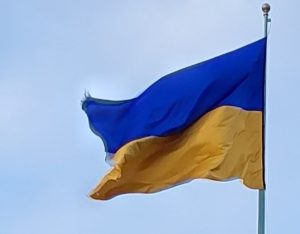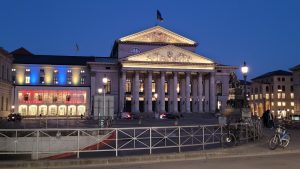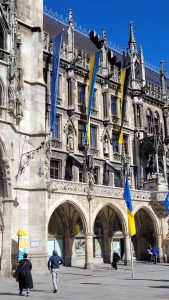In
Blog 2022
hanni geiger
Italy chooses the past headlined the
Frankfurter Allgemeine newspaper in February 2013, shortly after the Milan Fashion Week.
[1] It was referring to the colourful and pompous Dolce & Gabbana Spring/Summer Collection, significantly titled
Italianità: the designers‘ homage to the ‘old values’ of the crisis-ridden European country on the Mediterranean.
[2] The PR campaign celebrated the stereotype of
dolce vita in various photographs and glorified tradition and its revival.
Buon cibo,
café and
vino, luxurious craftmanship and materials of the highest quality, a southern Italian landscape flanked by well-dressed people in a cheerful mood against a sunny seaside backdrop — imagined, constructed and narrated from the nation‘s own perspective.
In one of the following campaigns, too, the timelessness of the ‘Italian lifestyle’ characterised the designs of both clothes and people. Under the title
Italia is Love (2016), the designers gathered all conceivable set pieces thought to represent an Italian maritime
passata quotidianità,
[3] referring to a Eurocentrically Mediterranean image of everyday life that transposes a one-sided version of its past into the global present. The particular asymmetry of past and present on the Mediterranean is evident in the distinctly staged and narrated embodiments and (image) practices from a solely Western gaze.
Against the backdrop of globalisation’s multidimensionality and complexity, the images reveal marginalised bodies, relativise proximity and distance and disrupt a supposedly universal narrative, thus showing the Mediterranean from its socially, politically and economically dis:connective side.
Visible Invisibilities
The highly controversial title of Dolce & Gabbana‘s Spring/Summer Collection 2013
Italianità, that is ‘Italianity’ or ‘being Italian’ can be traced back to the pan-Italian movement in the nineteenth century and nationalist ideologies of the twentieth century.
[4] These tendencies were associated with the forced Italianisation and the formation of a large Italian state, silencing voices on the east and south of the Mediterranean.
[5] Under this colonial policy, the term stood for a unified identity comprehending the essence, nature and character of the country and its inhabitants
[6] in their formative linguistic, cultural and political dominance in the region.
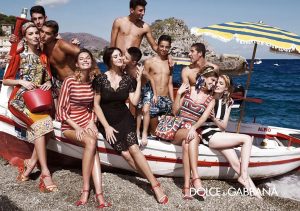
Dolce & Gabbana, Spring/Summer Advertising Campaign 2013. In: Dolce & Gabbana. 2013. „Spring/Summer Advertising Campaign 2013.“ Maria Speaks Prada, January 16, 2013. https://www.msf.org/five-things-know-about-search-and-rescue-crisis / © Dolce & Gabbana.
However, this repressive part of Italian history is largely hidden behind the images of Dolce & Gabbana‘s press campaign, which circumscribes this problematic term in marketing and everyday life. Since the 1950s
Italianità has stood for a broadly applicable Mediterranean culture of ease, ‘sea, sun and love’, familiar since the tourism boom and the labour migrations from Italy to the European north.
[7] So what the designers present to us is a red-and-white fishing boat on a Sicilian beach, with attractive women and men draped in front of it, models as well as amateurs from the area, who are indulging in sunbathing and serene togetherness. Amongst other model-stars, we recognise celebrities, such as Monica Bellucci — Italian acting icon and global epitome of the dark-haired, pale-skinned ‘Mediterranean beauty’.
[8] Fabricating a universally valid maritime imaginary, these sensual bodies in classic, tight-fitting dresses in vivid colours, patterns and ornamentation against a deep blue seascape recall the formation of a Mediterranean topos that was dominated by Italy's imperial politics in the 1930s
[9] and the entertainment industry in the 1950s and 1960s. Design has always played a major role here. The industrialised states on the Mediterranean shaped their colonies in the region and around the globe by strategically disseminating their own brands, such as Fiat or Vespa, which featured in movies, billboards and ads.
[10]
Even today, Dolce & Gabbana design the single valid Mediterranean universe based on a Eurocentric selection of bodies dressed up in Italy‘s glorified (design) past. To this day, design testifies to power and claims on territories and people, substantiating them with Western narratives. As a child of industrialisation, design follows capitalist and post-imperial principles, thus reflecting the region’s dis:connectivity in its economic and social imbalances.
These and other visual representations of a unified Mediterranean under Western control go hand in hand with its theoretical constructions, which mostly draw on its past as a European model of civilisation that can still be felt today. Concepts of a romanticised
Méditerranée or
Mediterraneitá influenced by the imperial and, later, fascist regimes played leading roles as both abstract ideas of colonial dominance and of unification strategies that also imposed themselves aesthetically.
[11]
In its production, dissemination and narrativisation, the photo from Dolce & Gabbana‘s press campaign inevitably reveals what should remain hidden: the many layers of unacknowledged histories that have shaped and continue to shape the Occidental frame. The one-sidedness resulting from the Western gaze turned on itself must therefore be understood as the practice of hegemonic knowledge production that is always accompanied by the disconnective absence of other images and (body) narratives.
The ir:regular Mediterranean
The inevitability of apprehending the globalised Mediterranean with its bodies in anything but universal terms becomes evident in the social, political and economic dis:connectivity of the region and its people. The wars in south-eastern Europe in the 1990s, the Arab Spring, migrations from Africa and the so-called ‘Balkan route’ travelled by refugees that runs through countries along the Mediterranean represent the errors, frictions, deviations and disorder of multiple Mediterranean realities. The press photographs of refugees off the same Italian coast where Dolce & Gabbana staged their campaign illustrate these dis:connectivities.
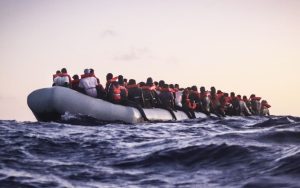
Hannah Wallace Bowman, Migrant Boat off the Sicilian Coast, August 2020, Photograph, August 2020, https://www.msf.org/five-things-know-about-search-and-rescue-crisis.
Although the photographs of Libyan migrants are subject to other practices and contexts than in design, they are shot from the same Eurocentric perspective, disseminated and narrativised through the media, threatening a Mediterranean attributed exclusively to Western nation-states. In contrast to the expensively outfitted and digitally altered white bodies of an economic elite from the global North, the news images of the unembellished dark bodies breaking out from the southern shores of the region represent a disruption and destabilisation of hegemonic beliefs as they diffuse throughout the internet. The bodies marked by the arduous flight merge into one undifferentiated mass of otherness without individual dignity. Uniformed in orange life jackets on a roaring dark sea, the bodies made alien threaten the geo-political, cultural, linguistic and religious borders that demarcate Europe. These bodies do not always reach the Northern beach staged in fashion advertising alive.
The disconnective side of globalisation finds expression here. The sea, naturally fluid and moving but which law renders frozen and static, becomes the dividing wall behind which the imperial past and its excluded masses lie buried.
[12] With the immigration of the disconnected bodies marked as illegal, the ghosts of the colonial
mare nostrum are awakened, against which only a politically practised selection of bodies seems effective.
Accordingly, Dolce & Gabbana‘s summer 2016 collection — ironically presented shortly after the first reports of migrant boats sinking off the Italian coast — celebrates
Italianità, this time under the motto
amore.
[13] A love that, as the campaign reveals, is only granted to the privileged migrating bodies of the shopping and consumption-hungry ‘[…] foreign tourists, who have landed in their much-loved Italy […]’.
[14] Belonging coincides with the exclusion of uninvited guests and their bodies, bodies carrying not only the past, but the colonial constitution of the Mediterranean present.
[15] These disturbing bodies are never to be declared problems of the ‘others’ or as flaws of globalisation, but understood as an essential part of Western hegemonies. Iain Chambers aptly captures this, seeing in migration neither an external event, nor an overflow of otherness onto European shores nor even a crisis, but rather ‘the building block of European modernity’.
[16]
The exclusion of the unwanted dead and live bodies washed up on the European shores is rooted in a dis:connective globalisation based on unequal power relations — management of the Mediterranean solely from the northern shores.
[17]
Chambers pleads for a critical gaze towards the Occident and demands confrontation with unacknowledged histories that have shaped and continue to shape the ‘Western archives’.
[18] Grasping the past in the present
[19] enables narration of the dis:connective Mediterranean, referring to neglected actors, artefacts and their practices, from other perspectives and with reference to other critical theories. The Portuguese postcolonial writer Hélia Correia finds a fitting image for this comprehension of past in the present when she speaks of Europe as a lady wearing
haute couture, whose expensive dresses hide the body of a dirty, scabby and sick Europe.
[20] Mediterranean imperialism, veiled under precious Dolce & Gabbana clothes, is exposed by snapshots of migrants off the same coast. The vaunted ‘old values’ — the Occidental humanistic definitions of locality, home, national identity, tradition and belonging — become worthless.
The point to remember is the fundamental importance of visual and haptic artefacts for the formation of images and meanings, as seen in the prototypes of a simultaneously connected and disconnected Mediterranean (body). Instead of the monolithic dualism in the Western construction of the self and ‘other’, the absent, so-called Mediterranean ‘rest' is to be recalled. Its cultural and creative diversity as well as its indefinability according to dominating concepts can be traced through design practices dis:connected to and from the West.
Instead of the Eurocentric production of aesthetics and narratives, it is necessary to create a new framework in which the hegemonically perceived defectiveness, the deviant and the ambiguous of (Mediterranean) societies becomes susceptible to research and ‘world-building’ beyond nations.
[1] Alfons Kaiser, ‘Italien Wählt Die Vergangenheit’, Frankfurter Allgemeine Zeitung, 26 February 2013, https://www.faz.net/aktuell/stil/mode-design/mode/mailaender-modewoche-italien-waehlt-die-vergangenheit-12095449.html.
[2] ‘Colourful Dolce & Gabbana Spring / Summer 2013 Ad Campaign’, Global Fashion Report, 2013, https://globalfashionreport.com/colourful-dolce-gabbana-spring-summer-2013-ad-campaign-photos.
[3] ‘Italia Is Love. CAMPAGNA PUBBLICITARIA ESTATE 2016’, Italia is Love, 2016, https://world.dolcegabbana.com/it/discover/dolce-gabbana-estate-2016-italia-is-love-ispirazione-campagna-pubblicitaria/.
[4] Gualtiero Boaglio, Italianità: Eine Begriffsgeschichte, 1., 2008.
[5] Boaglio.
[6] Boaglio.
[7] ‘Italianità in Der Schweiz – Caffè, Vespa Oder Bagnino: Sechs Schweizer Fotografen Mit Italienischem Blut Zeigen, Was Bei Ihnen Heimatgefühle Auslöst.’, Migros-Magazin, 8 March 2015.
[8] ‘Monica Bellucci, Il Make up Dell’icona Di Bellezza Mediterranea’, LetteraF, 30 September 2014, https://www.letteraf.com/monica-bellucci-make-dellicona-bellezza-mediterranea/.
[9] ‘Als Die Moderne Noch Geholfen Hat’, Frankfurter Allgemeine Zeitung, 7 October 2017.
[10] Anthony Downey, ‘Dissonant Archives: Contemporary Visual Culture and Contested Narratives in the Middle East’, 16 July 2015.
[11] Andreas Eckl, ‘Méditerranée? Mediterranistische Diskurse Um Mittelmeerwelten Und -Räume Aus Forschungsgeschichtlicher Perspektive’, in New Horizons Mediterranean Research in the 21st Century, Mittelmeerstudien 10 (Paderborn, 2016), 109–53; Jean-Francois Lejeune and Michelangelo Sabatino, ‘The Politics of Mediterraneità in in Italian Modernist Architecture’, in Modern Architecture and the Mediterranean (London: Routledge, 2009), 41–63.
[12] Imaginaries of Europe. Rethinking Identity, Belonging and Sovereignty Europe: From Hope to Disaffection (Barcelona, 2018), https://www.cccb.org/en/multimedia/videos/imaginaries-of-europe-rethinking-identity-belonging-and-sovereignty/229536.
[13] Hannah Marriott, ‘Dolce & Gabbana Shares the Amore in Milan with Jolly 50s Italy Collection’, 27 September 2015, https://www.theguardian.com/fashion/2015/sep/27/dolce-gabbana-shares-the-amore-in-milan-with-jolly-50s-italy-collection.
[14] ‘Italia Is Love. CAMPAGNA PUBBLICITARIA ESTATE 2016’.
[15] Imaginaries of Europe. Rethinking Identity, Belonging and Sovereignty Europe: From Hope to Disaffection.
[16] Iain Chambers, ‘Postcolonial Interruptions, Unauthorised Modernities’, in Postcolonial Interruptions, Unauthorised Modernities (New York/London: Rowman & Littlefield Publishers, 2017), 37–60.
[17] Lidia Curti, ‘Diasporic Female Narratives: Crossing the Mediterranean, Rewriting Italy.’ (Mediterranean Mediations with Iain Chambers and Lidia Curti, John Hope Franklin Humanities Institute at Duke University, 20 March 2019), https://www.youtube.com/watch?v=czr5N4oFBAY&t=6846s; Iain Chambers, ‘Mediterranean Blues – Thinking with the Diver.’ (Mediterranean Mediations with Iain Chambers and Lidia Curti, John Hope Franklin Humanities Institute at Duke University, 20 March 2019), https://www.youtube.com/watch?v=czr5N4oFBAY&t=6846s.
[18] Chambers, ‘Postcolonial Interruptions, Unauthorised Modernities’.
[19] Chambers, ‘Mediterranean Blues – Thinking with the Diver.’
[20] Hélia Correia, ‘Portugal lesen!’, Video, 3sat-Kulturdoku (3sat, 19 March 2022), https://www.3sat.de/kultur/kulturdoku/portugal-lesen-100.html.
bibliography:
Frankfurter Allgemeine Zeitung. ‘Als Die Moderne Noch Geholfen Hat’, 7 October 2017.
Boaglio, Gualtiero.
Italianità: Eine Begriffsgeschichte. 1., 2008.
Chambers, Iain. ‘Mediterranean Blues – Thinking with the Diver.’ Presented at the Mediterranean Mediations with Iain Chambers and Lidia Curti, John Hope Franklin Humanities Institute at Duke University, 20 March 2019. https://www.youtube.com/watch?v=czr5N4oFBAY&t=6846s.
———. ‘Postcolonial Interruptions, Unauthorised Modernities’. In
Postcolonial Interruptions, Unauthorised Modernities, 37–60. New York/London: Rowman & Littlefield Publishers, 2017.
Global Fashion Report. ‘Colourful Dolce & Gabbana Spring / Summer 2013 Ad Campaign’, 2013. https://globalfashionreport.com/colourful-dolce-gabbana-spring-summer-2013-ad-campaign-photos.
Correia, Hélia. ‘Portugal lesen!’ Video.
3sat-Kulturdoku. 3sat, 19 March 2022. https://www.3sat.de/kultur/kulturdoku/portugal-lesen-100.html.
Curti, Lidia. ‘Diasporic Female Narratives: Crossing the Mediterranean, Rewriting Italy.’ Presented at the Mediterranean Mediations with Iain Chambers and Lidia Curti, John Hope Franklin Humanities Institute at Duke University, 20 March 2019. https://www.youtube.com/watch?v=czr5N4oFBAY&t=6846s.
Downey, Anthony. ‘Dissonant Archives: Contemporary Visual Culture and Contested Narratives in the Middle East’, 16 July 2015.
Eckl, Andreas. ‘Méditerranée? Mediterranistische Diskurse Um Mittelmeerwelten Und -Räume Aus Forschungsgeschichtlicher Perspektive’. In
New Horizons Mediterranean Research in the 21st Century, 109–53. Mittelmeerstudien 10. Paderborn, 2016.
Imaginaries of Europe. Rethinking Identity, Belonging and Sovereignty Europe: From Hope to Disaffection. Barcelona, 2018. https://www.cccb.org/en/multimedia/videos/imaginaries-of-europe-rethinking-identity-belonging-and-sovereignty/229536.
Italia is Love. ‘Italia Is Love. CAMPAGNA PUBBLICITARIA ESTATE 2016’, 2016. https://world.dolcegabbana.com/it/discover/dolce-gabbana-estate-2016-italia-is-love-ispirazione-campagna-pubblicitaria/.
‘Italianità in Der Schweiz – Caffè, Vespa Oder Bagnino: Sechs Schweizer Fotografen Mit Italienischem Blut Zeigen, Was Bei Ihnen Heimatgefühle Auslöst.’
Migros-Magazin, 8 March 2015.
Jean-Francois Lejeune, and Michelangelo Sabatino. ‘The Politics of Mediterraneità in in Italian Modernist Architecture’. In
Modern Architecture and the Mediterranean, 41–63. London: Routledge, 2009.
Kaiser, Alfons. ‘Italien Wählt Die Vergangenheit’.
Frankfurter Allgemeine Zeitung, 26 February 2013. https://www.faz.net/aktuell/stil/mode-design/mode/mailaender-modewoche-italien-waehlt-die-vergangenheit-12095449.html.
Marriott, Hannah. ‘Dolce & Gabbana Shares the Amore in Milan with Jolly 50s Italy Collection’. 27 September 2015. https://www.theguardian.com/fashion/2015/sep/27/dolce-gabbana-shares-the-amore-in-milan-with-jolly-50s-italy-collection.
LetteraF. ‘Monica Bellucci, Il Make up Dell’icona Di Bellezza Mediterranea’, 30 September 2014. https://www.letteraf.com/monica-bellucci-make-dellicona-bellezza-mediterranea/.
citation information
This post has also appeared in issue 1.1 of our in-house journal, static.
Geiger, Hanni. ‘Past:Present Represent. Imaging Dis:Connected Mediterranean Bodies’. Static. Thoughts and Research from Global Dis:Connect, 2022.
Continue Reading
 Our new fellow Katarzyna Puzon has recently co-edited the book "Islam and Heritage in Europe: Pasts, Presents and Future Possibilities". On her behalf, we would like to point you to the hybrid presentation of the book on Monday, 11 July 2022. Looking at diverse trajectories of people and things, the volume examines developments in various parts of Europe, including France, Germany, Russia, Turkey, and the Balkans. At a roundtabel discussion, the participants will talk about entanglements between heritage, Islam and Europe and ways in which these entanglements have played out against the backdrop of recent developments, such as debates on restitution, decolonising museums or the 'refugee crisis'. The roundtable discussion will include inputs from Wendy Shaw, Peter McMurray, Jesko Schmoller, Avi Astor, Diletta Guidi, Banu Karaca, Mirjam Brusius, Christine Gerbich and Rikke Gram, and the editors, Katarzyna Puzon, Sharon Macdonald and Mirjam Shatanawi.
Our new fellow Katarzyna Puzon has recently co-edited the book "Islam and Heritage in Europe: Pasts, Presents and Future Possibilities". On her behalf, we would like to point you to the hybrid presentation of the book on Monday, 11 July 2022. Looking at diverse trajectories of people and things, the volume examines developments in various parts of Europe, including France, Germany, Russia, Turkey, and the Balkans. At a roundtabel discussion, the participants will talk about entanglements between heritage, Islam and Europe and ways in which these entanglements have played out against the backdrop of recent developments, such as debates on restitution, decolonising museums or the 'refugee crisis'. The roundtable discussion will include inputs from Wendy Shaw, Peter McMurray, Jesko Schmoller, Avi Astor, Diletta Guidi, Banu Karaca, Mirjam Brusius, Christine Gerbich and Rikke Gram, and the editors, Katarzyna Puzon, Sharon Macdonald and Mirjam Shatanawi.





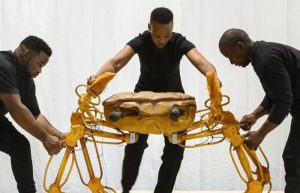 We are very happy to announce that the Ukwanda Puppets Collective will be performing at the Staatstheater Augsburg. Their performance titled: Isikhalo Somlambo/Der Ruf des Wassers will premiere on the 12 July 2022. Performances will continue till July, 16th. The collective are artists in residence at
We are very happy to announce that the Ukwanda Puppets Collective will be performing at the Staatstheater Augsburg. Their performance titled: Isikhalo Somlambo/Der Ruf des Wassers will premiere on the 12 July 2022. Performances will continue till July, 16th. The collective are artists in residence at 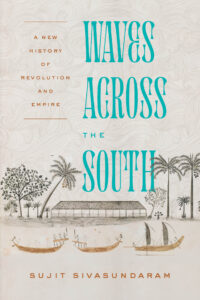 We are proud to report that our fellow Sujit Sivasundaram’s latest book ‘
We are proud to report that our fellow Sujit Sivasundaram’s latest book ‘

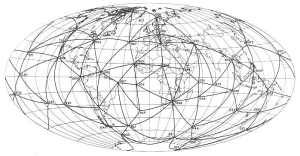


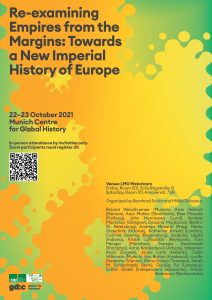 Together with the Munich Centre for Global History, global dis:connect recently had the privilege of hosting a stimulating workshop titled Re-examining Empires from the Margins: Towards a New Imperial History of Europe, organised by the inimitable
Together with the Munich Centre for Global History, global dis:connect recently had the privilege of hosting a stimulating workshop titled Re-examining Empires from the Margins: Towards a New Imperial History of Europe, organised by the inimitable 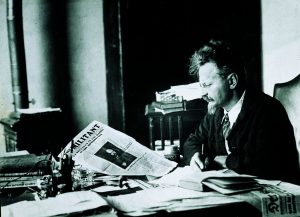
 A warm welcome to our new fellow Martin Rempe who joins the Kolleg until autumn.
A warm welcome to our new fellow Martin Rempe who joins the Kolleg until autumn.